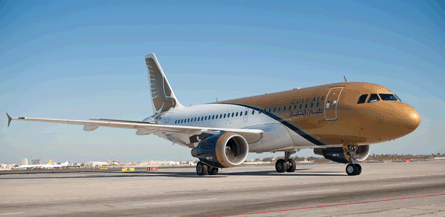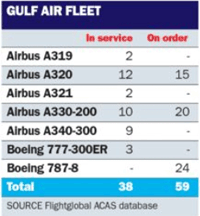Gulf Air's new chief executive has unveiled an "immediate redirection of strategy" for the loss-making Bahraini carrier that will see it focus on short-haul operations and realign its network towards strong connections through its hub under a three-year restructuring programme.
Samer Majali, who took the helm of the airline in July having previously run Royal Jordanian, says that Gulf Air is likely to post an operating loss of 193 million Bahrain dinars ($512 million) for 2009, which he says is equivalent to 28% of Bahrain's deficit.
The airline is seen as a burden on the national economy, a problem that has mounted since Bahrain's government took on sole ownership, and other operators in the region - notably those belonging to Gulf Air's former owner states Abu Dhabi (Etihad Airways) Qatar and Oman - have competed for connecting passengers.
 |
|---|
© Gulf Air |
Outlining a three-point business plan, with the target to achieve commercial sustainability in 2012, Majali told Flight International that the airline will simplify its fleet to operate narrowbody types - the Airbus A320 family and a batch of regional jets - to serve main routes, with a number of long-haul aircraft assigned to financial centres. A possible link with one of the global alliances is also a possibility.
The transition will be undertaken in two phases: the realignment of the network over the next six to 12 months, followed by growth into new markets and product development in the second and third years. Majali admits that the plan involves a "significant resizing" of the workforce, but should will save the Bahraini government up to $2.65 billion in support over the next five years.
"The simplified fleet has some technical challenges and high unit costs but, on balance, provides increased flexibility with reduced maintenance and organisational costs, limited total exposure, and would be more attractive to potential commercial partners."
Gulf Air's management considered five restructuring options in its review of the carrier before deciding that nothing short of an extensive overhaul was necessary to make the Bahrain-based airline profitable.
Majali expects to introduce a fleet of eight to 12 regional jets between 2010 and 2012, with the intention to "make an impact" on regional routes. "We'll probably lease some aircraft in on short-term leases to try the concept out," he says.
Gulf Air will use the jets to experiment on routes that have not attracted interest from the major airlines in the area.
 |
|---|
"Primary airports are well served, but we have underserved secondary airports," he says.
Majali gained experience with introducing Embraer E-Jets to Royal Jordanian. But he says Gulf Air has not decided on a type, and is in discussions with Bombardier and Embraer.
While he does not rule out the Mitsubishi MRJ regional jet, Majali concedes that this is a longer-term prospect, and he adds that the Bombardier CSeries is a "viable option".
He says that the current fleet - consisting of A320 family aircraft, A330/A340s and leased Boeing 777-300ERs - effectively includes several additional aircraft types because of differing configurations, which made the operation "difficult".
The airline has 15 A320s on backlog and recently began taking delivery of a new batch that it intends will replace some of its older examples.
It plans to increase the A320 order, but is still in discussions about the number of A330s and Boeing 787s it requires - it currently has a backlog of 20 and 24, respectively.
The airline has also indicated that it will sell five of its nine A340-300s and dispose of "certain other aircraft" that it no longer needs.
"The plan is for a larger narrowbody fleet than we have on order and a smaller widebody fleet. We are talking to the aircraft manufacturers about aligning our orderbook with this strategy," says Majali.
The A330s are due for delivery from 2012 and Majali says that they were never envisaged to "operate side by side" with the 787, as the Dreamliner was intended to succeed them.
To refine its network the airline will cut up to 15 routes - among them Shanghai, Hyderabad and Bangalore - in favour of expanding into more than 20 new destinations, to reinforce Bahrain's position as a connecting hub.
Majali concedes that the airline, which was once the Gulf's primary network carrier, is also feeling the squeeze from the region's increasing number of low-fare airlines. He says these carriers have put pressure on ticket prices, while premium traveller numbers have fallen: "Without the relative scale to dominate its markets, Gulf Air must frequently discount to win customers - without even considering differences in product."
Various funding options are being evaluated to support the restructuring, although these do not include a near-term strategic partnership. Majali says that the funding would be "difficult to find internally" and that the airline will probably have to undergo an increase in capital, or seek a regular finance avenue.
Source: Flight International























